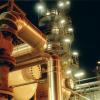I'm doing on PSV sizing which is designed for fire case.
To sizing it's required relieving capacity.
i followed API 520 to calculate but it ends up with answer in BTU/hr units.
i need the relieving rate in GPM units
Does anybody could help me with this?
one more questions..
At the water treatment system,Central processing platform in energy industrial
there's a PVSV at the downstream of IGF unit and i also need to calculate relieving capacity.
the PVSV located at a line to vent the fluid to flare .
what type does the fluid supposed to be? gasoline or what?
i need to assume the type of fluid and its compositions to calculate latent heat and molecular weight.
i appreciated all of your answers
very thank you
|
|
4 replies to this topic
Share this topic:
#1

Posted 13 May 2012 - 01:20 PM
#2

Posted 13 May 2012 - 11:11 PM
Dear MusaP1,
I am answering to your first question.
When you are sizing PSV for external fire, one of the two cases you have to consider, ‘gas expansion’ or ‘liquid vaporisation’. I believe you have considered ‘liquid vaporisation’ case as you are getting your result in’ BTU/hr ‘, i.e. total heat absorbed as per equation (6) or (7), API-521, fifth edition (I hope this is not ‘gas expansion’ case because you will get the result in lb/hr, i.e. relieving rate as per equation (12), API-521, fifth edition. I do not think API-520 has any equation for relieving capacity determination (I think so as I have not come across with such equation, rather API-520 provides equations for area calculations).
In liquid vaporization case, you can get latent heat of vaporization at relieving condition.
Divide the value with heat absorbed as per equation (6) or (7), API-521, fifth edition and you will get mass flow rate.
Divide the mass flow rate with density and you will get the volumetric flow rate you require.
Thanking You
Simadri
I am answering to your first question.
When you are sizing PSV for external fire, one of the two cases you have to consider, ‘gas expansion’ or ‘liquid vaporisation’. I believe you have considered ‘liquid vaporisation’ case as you are getting your result in’ BTU/hr ‘, i.e. total heat absorbed as per equation (6) or (7), API-521, fifth edition (I hope this is not ‘gas expansion’ case because you will get the result in lb/hr, i.e. relieving rate as per equation (12), API-521, fifth edition. I do not think API-520 has any equation for relieving capacity determination (I think so as I have not come across with such equation, rather API-520 provides equations for area calculations).
In liquid vaporization case, you can get latent heat of vaporization at relieving condition.
Divide the value with heat absorbed as per equation (6) or (7), API-521, fifth edition and you will get mass flow rate.
Divide the mass flow rate with density and you will get the volumetric flow rate you require.
Thanking You
Simadri
#4

Posted 15 May 2012 - 12:45 AM
Hi, I'm doing relief rate calculations on a sand separator. I need general guidance about the fire case calculations i.e. should I consider liquid and aqueous case for the calculations?
#5

Posted 25 May 2012 - 03:15 AM
Harshuch,
Your question is not connected to the original post. If you want to ask a new question, please post it in a new thread,so that it can be seen separately from this thread.
If you want some useful replies to your question, you need to provide some more information. Such as - what is a sand separator? what fluids go through it? what is its design pressure? What do you mean by the "liquid" and the "aqueous" cases? A diagram would be helpful.
However, lacking any of this information, we can observe that the fire relief rate is related to the latent heat of the contained liquid. Lower latent heat will give a higher relief mass flowrate for a given heat input. From this conclusion you should be able to identify the case which has the highest relief rate.
Paul
Your question is not connected to the original post. If you want to ask a new question, please post it in a new thread,so that it can be seen separately from this thread.
If you want some useful replies to your question, you need to provide some more information. Such as - what is a sand separator? what fluids go through it? what is its design pressure? What do you mean by the "liquid" and the "aqueous" cases? A diagram would be helpful.
However, lacking any of this information, we can observe that the fire relief rate is related to the latent heat of the contained liquid. Lower latent heat will give a higher relief mass flowrate for a given heat input. From this conclusion you should be able to identify the case which has the highest relief rate.
Paul
Similar Topics
Psvs Relieving To Closed Drain SystemStarted by Guest__1angelia23_* , 12 Jan 2025 |
|

|
||
Gas Hydrate Inhibition: Calculations For Meg/methanol InjectionStarted by Guest_PYG_* , 30 Sep 2019 |
|

|
||
Storage Tanks Diked Area Fire Protection Using Foam MakerStarted by Guest_mkhattaby_* , 30 Jan 2025 |
|

|
||
How To Estimate The Circulation Rate For Amdea (Mdea 45Wt + Pz 5Wt) BeStarted by Guest_tokotof_* , 29 Nov 2024 |
|

|
||
Psv Release Rate Vs TimeStarted by Guest_stu_* , 30 Nov 2024 |
|

|

 FB
FB






